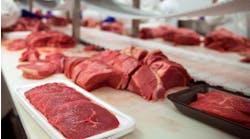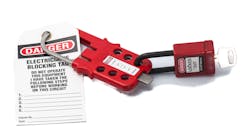Disruptions to the safety of the food supply comprise the most dreaded “accidents” the food industry faces. Yet history shows us there is no such thing as an accident. Time after time, investigations of food contamination lead to the conclusion that the crises were largely avoidable and that they often stem from faulty designs or construction materials that invited disaster.Food safety is, indeed, the most important issue any food company faces year-in, year-out. Its importance to public health, coupled with the potentially devastating consequences of a breakdown somewhere in the food safety web, have driven industry associations, sanitation and safety experts and watchdog organizations to establish guidelines not only for food handling, but for plant and process line design. Adhering to these recommendations can dramatically reduce the possibility of a devastating food safety event.Food safety hazards generally can be categorized as microbiological, chemical or physical. Most of the principles of safety revolve around the avoidance of entry, harborage or build-up in the facility — of anything that doesn’t belong, be it microbiological hazards, insects, rodents, plain old dirt, even unauthorized personnel. This principle is especially important at the points in the process where the product that will be ultimately consumed is most vulnerable.Whether your starting point is the facility, the people or a simple microbe, any piece of the food safety puzzle must be viewed as only a part of the total picture. Any complete food safety program should integrate employee programs, validated and verified processes, good manufacturing practices, sanitary equipment design, analyses of critical control points, and continuous improvement processes as well as sanitary facility design.
NOTE TO R&D
HACCP programs ask processors to understand their food processes, to identify key areas of risk and to control potential contamination at those critical junctures. But don’t neglect key areas of the plant that may lie outside the map of HACCP target zones.
Allen Sayler, senior director of regulatory affairs and international standards for the International Dairy Foods Assn. (IDFA), emphasizes the importance of safeguarding products beyond the borders of targeted “critical” control points. Such locales include storage areas for ingredients and ingredient blending areas, as well as the entire packaging area and finished product storage areas.
“A storage area for ingredients may not be a critical control point, but is it important? You bet it is!” says Sayler. “We don’t call it a critical control point, but it is a ‘foundation point.’ If ingredients are not handled properly, you’ve undermined the foundation of your food safety structure.”
|
“No matter how good the design of your plant or equipment is, if your employees are not trained in food safety, your operation is seriously at risk,” notes Craig Henry, vice president of the food safety program of the Food Products Assn. (formerly the National Food Processors Assn., still
www.nfpa-food.org), Washington. Such training should include a plan for disaster, a written and well-studied recovery plan for a worst-case scenario. A sanitary plant design follows three broad principles: providing zones of control; controlling temperature and moisture; and designing to facilitate sanitation.This last point is enormously important. Essential to the concept of a sanitary design is thorough cleanability. That means a facility in which you can clean out and eliminate not only debris and chemical substances but tiny microbial invaders as well. “The first principle of sanitary design is that the facility be cleanable to a microbiological level,” says Dave Kramer, vice president of engineering for Sara Lee Foods (
www.saralee.com), Chicago. “Food facilities and equipment must be constructed — and able to be maintained — to ensure that they can be effectively cleaned and sanitized over their life.” Kramer emphasizes the critical importance of removing all food particles and preventing bacterial ingress, survival, growth and reproduction on both product and non-product surfaces. Such factors as traffic, airflow, temperature, moisture, nutrients, pH, and competing organisms must all factor into sanitary design planning.
AMI’s ElevenFood processes involving raw animal protein pose some of the greatest dangers of contamination in the food industry. Last September, the American Meat Institute’s Facility Design Task Force established Eleven Principles for Sanitary Design of Facilities. Though the principles are geared toward operations involving meat, poultry and other animal proteins, they highlight concepts that processors from any segment of the industry can employ to reduce contamination risk.
1. Distinct hygienic zones established in the facility.Maintain strict physical separations that reduce the likelihood of transfer of hazard from one area of the plant, or from one process, to another area of the plant or process, respectively. Facilitate necessary storage and management of equipment, waste and temporary clothing to reduce the likelihood of transfer of hazards. The essence of the “hygienic zones” principle is the strict control of the movement of people and materials through the plant to prevent contamination and its spread. People can be intentional or unintentional carriers, staff personnel or visitors, involved or uninvolved in the direct manufacture of food product. Materials include: raw materials, packaging materials, trash, rework, inedible matter, uniforms and clothing, maintenance materials and parts, and sanitation chemicals. This principle incorporates hazard analysis of critical control points (HACCP), places where the food product is most vulnerable to contamination or where contaminants are most likely to build up or make entry. From that analysis should flow a plan to reduce the likelihood of contaminants entering the facility, let alone the food product. Sara Lee’s Kramer emphasizes the concept of having “zones of control.” Identifying such zones as raw processing, clean room area, packaging, cook/chill, etc. is Step One. A logical process flow and control of movement from one zone to another will help determine prevention capability.Personnel facilities — particularly locker rooms, showers and restrooms — should not open directly into a process area. Add an ante-room or hallway for separation.
2. Personnel and material flows controlled to reduce hazards.Establish traffic and process flows that control movement of production workers, managers, visitors, QA staff, sanitation and maintenance personnel, products, ingredients, rework and packaging materials to reduce food safety risks. Once you have established control zones in the plant, you can introduce controls to manage the flow of materials and people between these zones. “You need to consider how personnel move in the plant,” advises NFPA’s Henry. This is particularly important in a plant with multiple processes, and particularly in a plant where you have two very different processes, such as a process for raw product and a second for cooked product. When personnel and materials move freely from one process to another, the odds of contamination rise exponentially. “When you have movement of personnel, tools and parts from one area of the plant to another — say maintenance — you have a disease vector,” notes Henry. “Some facilities have elected to dedicate tools to one part of the plant. They may have dedicated employees, too. The tools, even uniforms of personnel, may be color-coded.”


